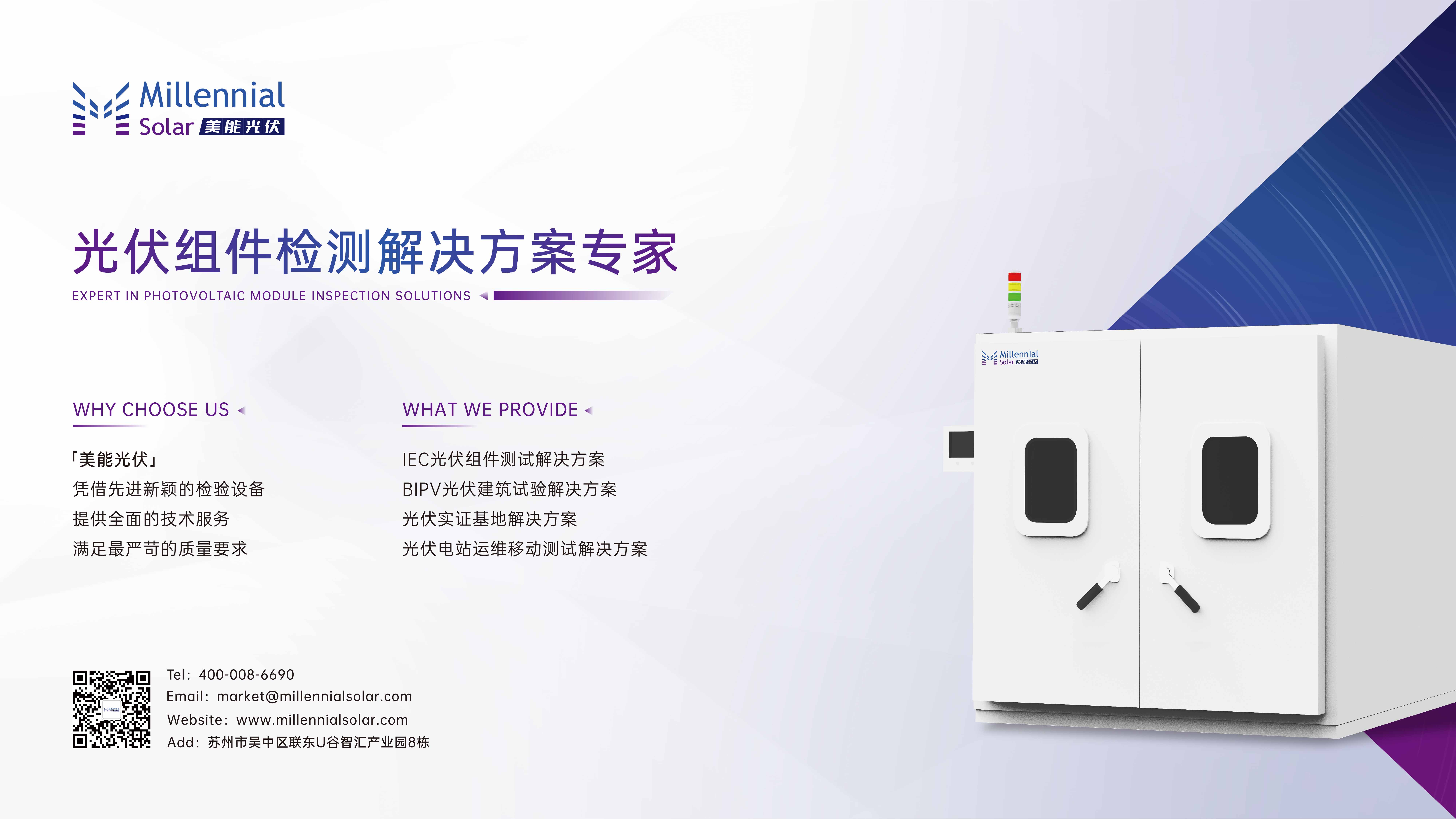
量子效率测试仪
PL/EL一体机
Sinton硅片少子寿命测试仪
Sinton硅块少子寿命测试仪
绒面反射率测试仪
3D共聚焦显微镜
清洗制绒工作站
在线四探针方阻测试仪
全自动扫描四探针方阻测试仪
在线薄膜厚度测试仪
晶化率测试仪
Horiba显微共焦拉曼光谱仪
傅里叶红外光谱仪
霍尔效应测试仪
分光光度计
全光谱椭偏仪
Horiba椭圆偏振光谱仪
TLM接触电阻率测试仪
超景深显微镜
网版智能影像测量仪
全自动影像测量仪
卧式拉力机
电池片稳态光衰老化试验箱
电池片紫外老化试验箱
电池片拉脱力综合测试仪
外观检验台
湿漏电测试系统
组件实验室EL测试仪
紫外老化试验箱
稳态光衰老化试验箱
电流连续性监测系统
PID测试系统
旁路二极管测试系统
LeTID测试系统
反向电流过载系统
脉冲电压测试系统
绝缘耐压测试仪
接地连续性测试仪
绝缘耐压接地测试仪
湿热环境试验箱
湿冻环境试验箱
热循环试验箱
动态机械载荷测试机
静态机械载荷测试机
冰雹冲击试验机
引出端强度试验机
霰弹冲击试验机
抗划伤(切割)测试机
剥离试验机
万能材料试验机(单臂)
万能材料试验机(双臂)
光伏玻璃透过率测试仪
醋酸测试试验箱
交联度测试系统
二极管接线盒综合测试仪
落球冲击试验机
半自动四探针
全自动探针式台阶仪
多通道太阳能MPPT系统
Horiba稳瞬态荧光光谱仪
钙钛矿P1激光划线测试仪
钙钛矿在线膜厚测试仪
钙钛矿工艺检测工作站
手持式IV测试仪
便携式EL测试仪
手持热成像测试仪
户外组件IV测试仪
户外组件多通道测试系统
光伏逆变器电能质量测试仪
无人机EL检测仪
逐梦相聚百河之城 | 美能光伏邀您共聚2023 PPIC 第十届光伏聚合物国际大会
日期:2023-07-31浏览量:20
近年来,随着光伏发电在全球电力供应中的占比越来越高,电池组件技术获得了空前的发展,低成本的电池技术压力和较短的创新周期,使光伏组件的市场占有率获得显著提升,更多高效的产品不断涌现,光伏组件的质量也越来越受到光伏企业用户的高度重视。「美能光伏」凭借其在光伏组件技术领域的独到经验,研制出先进新颖的检验设备,并针对各种光伏问题给予全面的技术服务,以满足用户严苛的质量要求。

为促进产业、技术、投资、应用、政府等多方合作共赢,「美能光伏」将于2023年7月27日-7月28日在江苏盐城建湖参加2023 PPIC - 第十届光伏聚合物国际大会,大会以“高效可靠,绿色创新”为主题,重点聚焦N型新型电池组件技术及大功率、大硅片、大组件和轻质柔性组件对原辅材料的封装解决方案和工艺把控。
本次大会将围绕胶膜、背板、硅胶(绝缘、导电、防水、灌封等)、丁基胶、封边胶、胶带、接线盒、复合材料边框、有机添加剂、胶粘剂、线缆等光伏聚合物材料技术的应用、市场和发展趋势进行深刻探讨,且分环节进行逐一讨论。
![]()
美能步入式温湿度环境试验箱

商务联系:张经理 400 - 008 - 6690
「美能光伏」所研发的美能温湿冻环境试验箱,凭借其先进新颖的检验设备,针对IEC61215、IEC61730测试标准,可在-40℃~-85℃的温度下温度冻结试验10个周期,并进行湿冷冻测试。可承受的温度范围在-50℃~+150℃左右,且风俗也可变频调节,具有防湿、防爆、透明、隔热、不易产生蒸汽结霜等优点。
想客户之所想,急客户之所急!优良的服务和精湛的检测技术是建立品牌和传播形象的有效手段,向用户提供精确稳定的优质设备,是美能光伏不断发展的动力所在,「美能光伏」将继续带着这份负山戴岳的责任,不断提高检测技术,笃行不怠!




































































